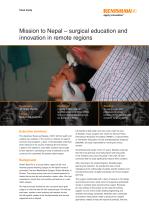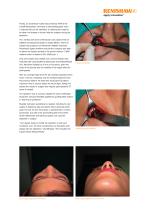
Catalog excerpts

Case study RENISHAW. apply innovation™ Mission to Nepal - surgical education and innovation in remote regions Customers: Mr Shakir Mustafa Industry: Medical and healthcare Challenge: A young mother required reconstructive work of her orbital floor and medial wall following a car accident in Nepal. Solution: To use pre-planned processes to create perfectly fitting implants with excellent surgical results. Executive summary The disastrous Nepal earthquake of 2015 left the health and surgical care systems of the country in disarray. To support and train local surgeons, a team of UK specialists undertook three missions to the country. Following the first mission a patient who suffered a road traffic accident was brought to their attention, culminating in what is believed to be the country’s first customised 3D printed orbital implant. Background Shashi Kala Rai is a young mother, aged just 28, who received ground-breaking surgery at the expert hands of consultant Oral and Maxillofacial Surgeon Shakir Mustafa, in Dharan. The young woman was one of several patients he treated during two aid and education mission visits. She had sustained an orbital floor and medial wall fracture in a road traffic collision. Rai had previously funded her own corrective bone graft surgery in India but was left with unequal eyes. The left eye was lower, sunken-in and scarring had reduced its size. Her left eyelids needed to be revised laterally and the eye supported and re-aligned. Life started to feel better once she came under the care of Mustafa, a busy surgeon who chairs the Norman Rowe International Education Foundation (NRIEF), a subcommittee of The British Association of Oral and Maxillofacial Surgeons’ (BAOMS), the body responsible for running this mercy mission. Scrutinising hard copies of her CT scans, Mustafa could see that the bone graft was incorrectly placed and lying partly in the maxillary sinus and only partly in the orbit. He was convinced that he could significantly improve Rai’s condition. After returning to the United Kingdom, Mustafa began planning the operation. He enlisted the help of local colleagues at the cutting edge of patient specific solutions and introduced the power of digital processes into his pre-surgical planning. The surgeon collaborated with a team of experts in 3D design and printing who had a track record of supporting predictable results in complex facial reconstructive surgery. Renishaw plc was enlisted in the project as the metal 3D printing supplier. As one of the world’s leading engineering and scientific technology companies, Renishaw also contributed its precision measurement skills to produce the complex geometries needed to help the implant fit perfectly, first time.
Open the catalog to page 1
Alignment before surgery from above Alignment before surgery from front Renishaw also donated the implant and offered financial support. Challenge Orbital implant procedures always carry the risks of causing blindness or double vision, because of the position of the optical nerve. In the NHS, such operations are always left to the most experienced surgeons. As the lead on maxillofacial trauma with special interest in orbital surgery, Mustafa handles all orbital reconstruction procedures for Cwm Taf University Health Board, South Wales. In this case, there were the added risks from being a...
Open the catalog to page 2
Finally, an anatomical model was printed by PDR at the Cardiff Metropolitan University in stereolithographic resin, a material that can be sterilised, so allowing the model to be taken into theatre to further help the surgeon during the operation. The .stl files were sent to Renishaw’s new state-of-the-art additive manufacturing facility in nearby Miskin, where an implant was produced on Renishaw’s AM250 machines. Renishaw’s digital workflow ensured the company was able to deliver the implant printed in the proven titanium Ti MG1 material which is tested to ISO 10993 part 1. Only one...
Open the catalog to page 3
Results This operation is believed to have been a first in many ways in Nepal: the first customised maxillofacial operation and the first 3D printed orbital implant surgery of any kind. The operation took twice as long as it would have taken in the UK, due to local conditions. There were four clinicians in the operating theatre and the procedure was watched by Nepalese and UK trainee surgeons, who assisted and observed for training purposes. By the time Mustafa left Nepal, Rai was still slightly swollen from her operation, but once the sutures were removed, she had normal visual acuity, no...
Open the catalog to page 4All Renishaw catalogs and technical brochures
-
LaserImplant™
1 Pages
-
inVia™ confocal Raman microscope
28 Pages
-
WiRE™ software
8 Pages
-
M6 CMM clamping kit
2 Pages
-
Renishaw CMM fixtures
36 Pages
-
3D modelling and printing
4 Pages
-
LaserAbutments™
4 Pages
-
DS10 system specifications
2 Pages
-
neuromate® stereotactic robot
17 Pages
-
Brochure neuromate
16 Pages
-
Brochure : Delivering precision
16 Pages
-
Neuroguide leaflet
2 Pages






















